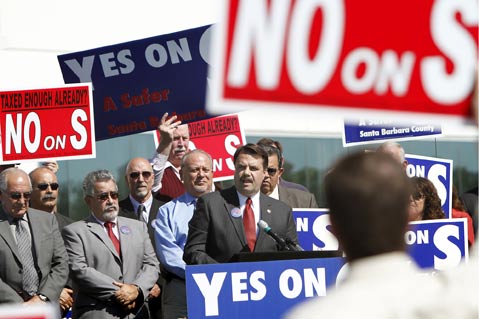Judges Support New Jail Tax
Anti-Tax Crusaders Oppose Measure S

As Sheriff Bill Brown and two superior court judges extolled the virtues of Measure S, the half-cent sales tax to fund a new North County jail, about 15 anti-tax activists affiliated with the Tea Party hoisted placards reading, “Taxed Enough Already.” With Measure S needing a two-thirds supermajority to pass, Brown took his message to the Betteravia Government Center in Santa Maria, where resistance to new taxes traditionally runs high. With the election three weeks away, Brown needs to minimize the margin of defeat in the north if Measure S is to have any chance of success. Helping Brown make his case were North County supervisors Joni Gray and Joe Centeno, both card-carrying conservatives and registered Republicans, as well as Judge Rogelio Flores and Judge Frank Ochoa.
Judge Flores highlighted the $5 million a year that Measure S would raise for intervention and prevention programs designed to reduce the recidivism rate — now at 72 percent — and keep repeat offenders out of jail. Flores spoke about the epidemic of methamphetamine abuse — more pronounced in the north than in the south — and the crying need for detox programs to get meth-heads clean and sober.
Judge Ochoa argued that a jail was needed in the North County because that’s where a majority of the jail’s inmates come from. The county can ill afford the cost of transporting prisoners from the south — where they’re now jailed — to the north — where they’re tried, Ochoa said. Like Flores, Ochoa focused on the $5 million a year Measure S will earmark for intervention programs. “These programs clearly work,” Ochoa said. “Just look at the success we’ve had with drug courts. We bring the numbers of people in jail down, and we give people a second start by treating them rather than incarcerating them.” Funding for these programs has grown increasingly problematic, said Ochoa. Measure S would provide a much-needed degree of financial stability.
From a dollars-and-cents perspective, Ochoa argued that Measure S added up. “If we don’t pass it, we lose $56 million,” he said, referring to the $56 million in state funds earmarked to help underwrite the cost of building a new jail, now estimated at $80 million. Those state funds, however, require a local contribution, and without Measure S, it’s unclear where Santa Barbara’s cash-strapped county government will find that money.
Ochoa argued that the need for a new jail is old news, having been written about in more than 20 grand jury reports over a four-decade span. Because of the space crunch, he said, people convicted of crimes serve only a small fraction of their sentences. “A sentence should mean what it means,” he said. “Someone looking at 45 days for a probation violation will maybe serve seven days.” A number of other judges have also come out in support of Measure S thus far, including judges Denise de Bellefeuille, Jed Beebe, Jean Dandona, George Eskin, and Commissioners Pauline Maxwell and Deborah Talmadge (retired).
Sheriff Brown retorted, “Let’s stop talking about what wasn’t done, and let’s start talking about what needs to be done.”
Sheriff Brown claimed that 18,000 prisoners have been released early because of jail overcrowding, 1,000 of whom re-offended during the time they would otherwise have still been behind bars. One was later convicted of murder.
Many of the anti-Measure S protestors were women with babies in tow. Conservative critics of Measure S have charged the tax is excessive and unnecessary, arguing that county supervisors could have funded construction of a new jail years ago had they set the money aside. Sheriff Brown retorted, “Let’s stop talking about what wasn’t done, and let’s start talking about what needs to be done.” After the press conference, Brown sought to engage some Tea Party activists in conversation about the need for Measure S, but according to Brown’s campaign manager, Jeremy Lindaman, he didn’t get too far. “It was like trying to teach a pig to sing,” commented Lindaman. “It wastes your time, and it pisses off the pig.”
If passed, Measure S would generate $30 million a year for 14 years. Half of that would fund jail construction and operations. The other half would be spent to underwrite intervention programs, fire protection, and law enforcement agencies throughout the county.



